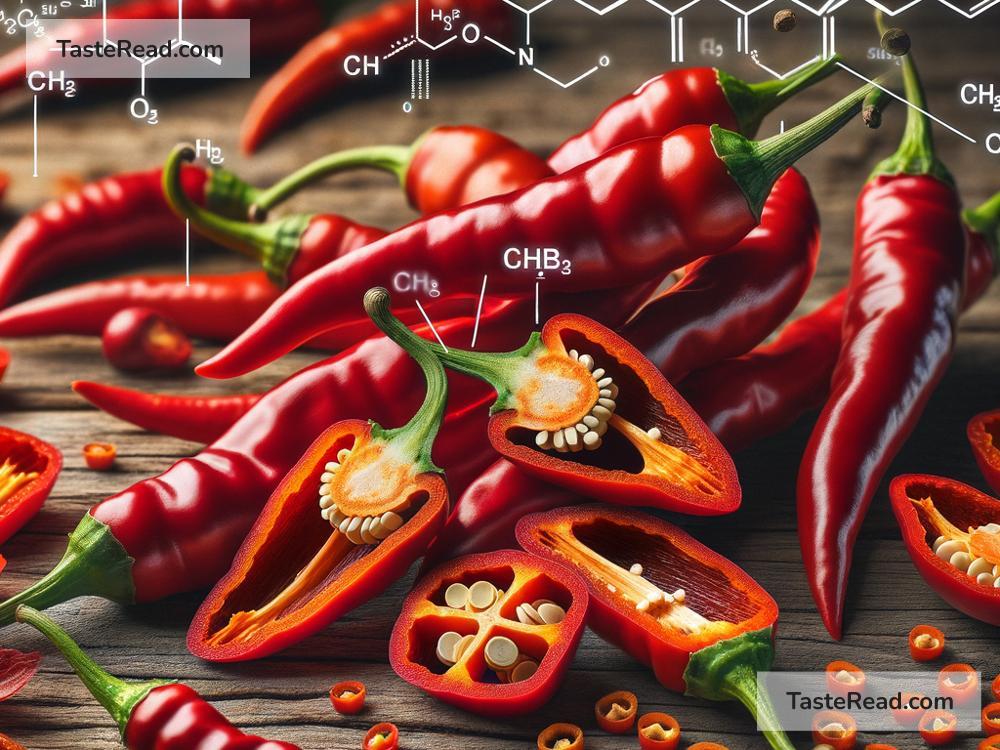The Chemical Basis of Spiciness in Vegetables Like Peppers
Have you ever bitten into a chili pepper and felt the fiery sensation spread across your mouth, leaving you reaching for water or milk? That intense heat is what we commonly call “spiciness,” and it all comes down to chemistry. Believe it or not, spiciness isn’t exactly a taste like sweetness or bitterness — it’s more of a feeling or sensation that’s triggered in your body. Let’s explore the chemical basis of spiciness and why some vegetables, like peppers, pack such a punch.
The Key Ingredient: Capsaicin
The sensation of spiciness in peppers comes from a chemical compound called capsaicin (pronounced cap-SAY-ih-sin). Capsaicin is primarily found in chili peppers, which belong to the Capsicum genus. This compound is produced by the peppers as a natural defense mechanism to deter animals and insects from eating them. Capsaicin is not harmful, but it feels intense because it interacts with the nerve endings in your body.
How Does Capsaicin Work?
Capsaicin isn’t something our taste buds detect like sugar (sweet) or salt (salty). Instead, it works by interacting with the pain receptors in your mouth (and sometimes your skin or eyes if you touch a chili pepper!). These receptors are part of the TRPV1 protein, which is responsible for detecting heat in the body.
When you eat something spicy, capsaicin binds to the TRPV1 receptors, tricking your brain into thinking there’s heat or pain — even though there’s no actual temperature change! So, the burning sensation you feel is essentially your body being fooled by chemistry. This is why spicy foods can make you sweat or your face turn red, similar to how you’d react in a genuinely hot environment.
The Scoville Scale: Measuring Spiciness
Not all peppers are equally spicy, and this is where the Scoville Scale comes in. The Scoville Scale measures the amount of capsaicin present in a pepper and ranks its heat level. The scale was created by Wilbur Scoville over 100 years ago and is still widely used today.
For example:
– Bell peppers rate zero on the Scoville Scale because they have no capsaicin.
– Jalapeños have a rating of 2,500 to 8,000 Scoville Heat Units (SHU).
– Habaneros can reach 100,000 to 350,000 SHU.
– Extremely hot peppers like the Carolina Reaper and Ghost Pepper exceed 1,000,000 SHU!
Capsaicin content is influenced by growing conditions, pepper variety, and even specific genes that make certain breeds of peppers naturally hotter than others.
Why Do Some People Enjoy Spicy Food?
You might think that eating spicy food — essentially triggering pain receptors — would be unpleasant. So why do so many people enjoy it? There’s some science behind this, too.
When your body experiences the heat sensation caused by capsaicin, it can release endorphins, which are chemicals in the brain that help relieve pain and boost feelings of happiness. For many people, the combination of spiciness and the “endorphin rush” makes spicy food exciting and enjoyable.
Additionally, spiciness has become culturally significant in cuisines around the world. In countries like India, Mexico, Thailand, and Korea, spicy food is a staple of many traditional dishes. Over time, people build a tolerance to the heat, allowing them to handle (and enjoy) even hotter foods.
Other Spicy Compounds in Nature
Capsaicin isn’t the only chemical responsible for spiciness. Other compounds can create a similar burning sensation, though they interact with your body slightly differently. Here are a few examples:
- Piperine: Found in black pepper, piperine gives black pepper its mild, sharp heat.
- Allyl Isothiocyanate: Responsible for the pungent spiciness in mustard, horseradish, and wasabi. Unlike capsaicin, this compound affects your nose more than your mouth.
- Gingerol: Found in ginger, gingerol creates a warm, slightly spicy sensation.
These compounds are chemically distinct from capsaicin but trigger the same heat-detecting receptors, producing varying types of “spicy” experiences.
How Can You Manage Spiciness?
If you eat something too spicy and need relief, water alone won’t do much. Capsaicin is an oil-based compound, which means it doesn’t dissolve in water. Instead, try consuming foods or drinks that can break down oily substances, like:
- Dairy products: Milk, yogurt, or cheese contain casein, a protein that helps wash away capsaicin.
- Starches: Bread or rice can absorb the spiciness, providing relief.
- Acidic foods: Lemon juice or vinegar can neutralize the capsaicin slightly.
Contrary to popular belief, drinking cold water might spread the capsaicin more, making things worse!
Fun Facts About Spiciness
- Capsaicin has health benefits! It’s been shown to promote metabolism, reduce inflammation, and may even help with pain relief in certain medical applications.
- Birds aren’t affected by the heat of capsaicin, which is why they can eat chili peppers without feeling the burn.
- “Super-hot” chili peppers are created through careful breeding, often combining varieties with high capsaicin levels.
Conclusion
Spiciness is more than just a flavor — it’s a chemical reaction between capsaicin and the pain receptors in your body. Peppers like jalapeños and habaneros contain varying amounts of capsaicin, giving them their signature heat. Whether you love the burn or avoid it altogether, understanding the science behind spiciness adds a new layer of appreciation to your meals. So the next time you’re sweating over a spicy dish, remember—you’re experiencing a fascinating chemical interaction that’s as much about sensation as it is about flavor!


